- The ultimate guide on how to choose wall art for your home
- Why choosing Wall Art? It’s more than decoration
- How to get started?
- Essential factors when choosing paintings for homes
- How to choose art for your home: Helpful Guidelines
- It’s all about stories
- Your Questions in Brief: FAQ
The ultimate guide on how to choose wall art for your home
Choosing wall art can be both enjoyable and daunting. If more experienced, you might see picking art as a welcome challenge to self-expression. Moved to a new home, the walls are still white and are demanding for you to take action? No need to be intimidated. Here is the ultimate guide on how to choose wall art for your home.
Why choosing Wall Art? It’s more than decoration
Art is much more than mere adornment or the icing on the cake. The right pieces will be the heart, spirit, and soul of your home. They can be the expression of your personality, exemplify your style, and transform the atmosphere of your spaces into something exquisite.
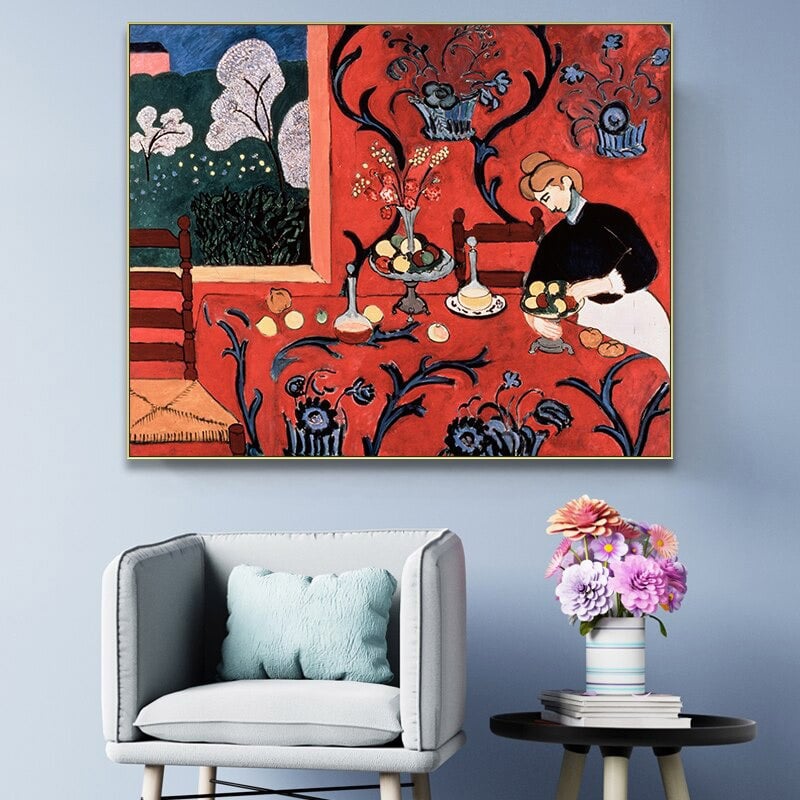
How to get started?
Start by asking yourself the following questions, which will help to build a basis for your art searching adventure and give you tools for how to choose art for your home:
What art do you see yourself drawn to?
You already possess a paintingPainting is a fundamental form of visual art that has been practiced for thousands of years. It involves applying pigment to a surface such as canvas, paper, or a wall. Painting can be explored through various styles, techniques, and mediums, each offering unique possibilities for expression and creativity. Historical Background • Ancient Beginnings: The history of painting dates back to More, print, or photograph that you absolutely love? Then you already have the best starting point. When still insecure about your own preferences, you can click through the artist section of our blog to see what you resonate with most. Does your heart sing when looking at abstract pieces such as a Pollock or a Rothko? Do you get excited when looking at the vibrant colours by van Gogh, or does it make you smile when looking at Magritte’s green apple in Son of Man?
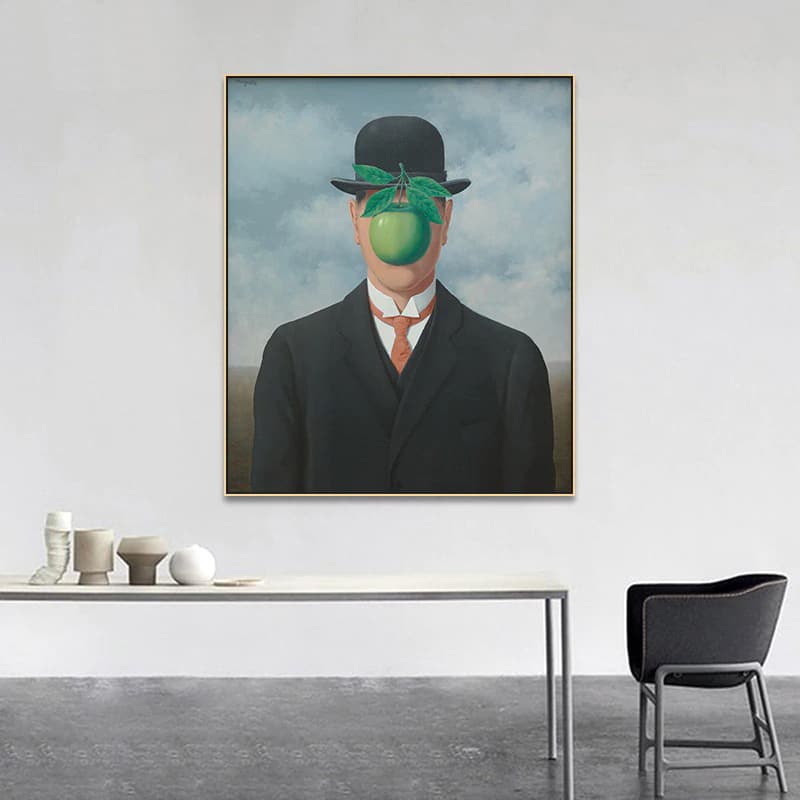
What do you want to achieve by hanging art?
You can choose artwork to blend into your home design or have your pictures standing out as focal points. Both can be achieved by wisely choosing themes, colours, formats, and the right spaces.
What is the overall atmosphere you want spaces to exude?
Art can evoke a variety of feelings. Do you want your artwork for the living room to give out a rhythmic vibe, should your space be harmonious? Are you looking for a piece that will not only be inviting for visitors but also be breathtaking? You might want to choose a piece for your bedroom that is soothing, or you might want it to be invigorating, structuring, and inspiring.
Essential factors when choosing paintings for homes
Having found your answers to these questions, we know the essential factors on which your endeavours of choosing wall art should be established on: The art you choose should foster feelings of enjoyment, relaxation, or excitement. Both you and your loved ones should adore the art, and it should strengthen the vibes of your own personality and that of your home.
How to choose art for your home: Helpful Guidelines
Considering the following design rules will help you develop a better understanding of what factors play a role in interior design when choosing wall art. However, consciously breaking these guidelines can oftentimes lead to extraordinary results.
#Space available
- A safe way of choosing wall art for a room is to first consider the proportions of the room, the size, and the shape of the free space on the wall. Like attracts the like, meaning, for example, that a high vertical wall space will be suitable for a large wall art in portrait format, or a wide horizontal spot above a long sofa will be just right for a broad artwork in landscape format.
- Read the blog article about the Art of hanging Art for more details on the height to hang your paintings for homes, spacing of pictures in groupings and collages, and how to adjust pictures in relation to furniture and objects in your rooms.
- Make sure that there is enough natural light for the colours of the picture to unfold their full potential. If buying original art, however, be careful not to expose your picture to direct sunlight, since it can harm sensitive pigmentsPigments are essential to the creation of art, providing the vibrant colors that artists use to bring their visions to life. These substances, derived from a variety of natural and synthetic sources, have a rich history and a wide range of applications in both traditional and modern art. Colour Pigments Definition and Composition • Pigment: A material that imparts color More. Don’t worry when purchasing art at Pigment Pool, since our high canvas wall art Giclée Prints are fade resistant.
- Allow for free space, since it highlights the art, making it the focal point. Don’t be claustrophobic.
#Picture sizes
Having gauged the space available, it is time to decide about the picture sizes. The general consideration is if you want a picture to stand alone or if you decide to combine several pictures in a grouping. When insecure or just starting off your art-choosing adventure, we recommend starting with a large wall art piece. Consider the following guidelines:
- Oversized formats are pictures 100 centimetres wide or longer. They usually serve as a focal point, such as a large canvas wall art piece above a sofa or a dining table.
- Large size formats span around 80 centimetres and can likewise act as a centrepiece. Pictures of this size can further be combined with smaller artworks to either side. A room should not include more than two large wall art pictures.
- Medium size formats are around 65 centimetres long and are optimal both for standing alone and in groupings. Refer to the conventional hanging rules for further instructions.
- Small size formats are around 50 centimetres in length and are suitable in groups of three or pairings of two. You can mix and match them with large wall art or in gallery walls.
- Mini size formats span around 30 centimetres and are ideal for collections of art of at least three pieces.
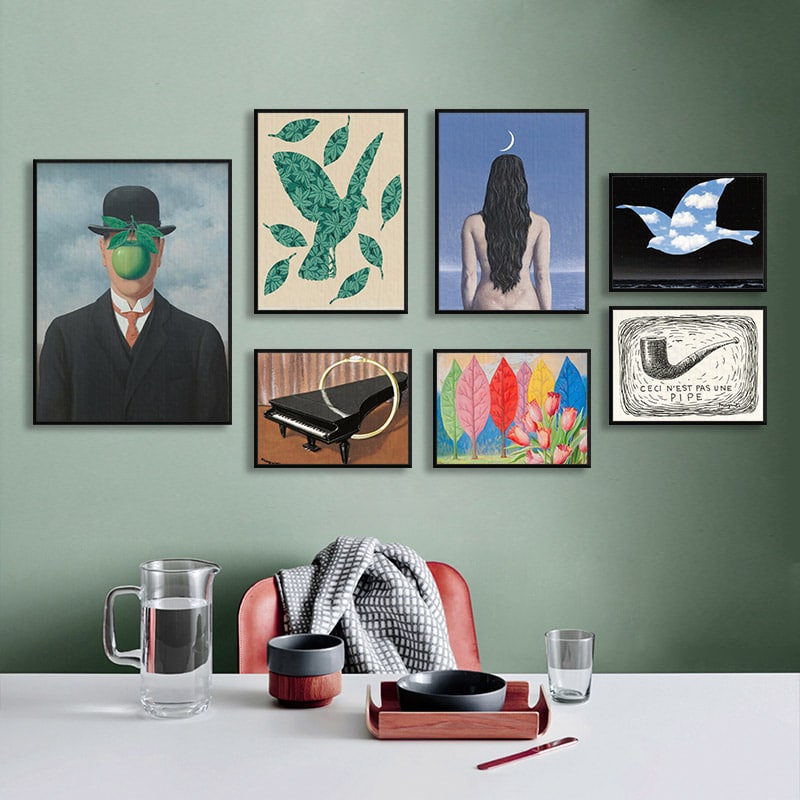
#Colours
Consider the colours in your room before placing a piece of art. While there are both good reasons for matching the existing colour palette and for choosing complementary colours, taking conscious approaches to colour decisions will be beneficial in either way.
Matching existing colours: When picking paintings for homes with colours already present in the room, the piece will appear to naturally merge into the scenery. It will unify the room’s atmosphere and overall appearance.
Choosing complementary colours: If you want your art to be a focal piece and to stand out from its surroundings, pick a piece that includes colours complementary to those to the objects in your room. For reference, use the colour wheelColour Wheel Art and Design: As a key element in colour theory, the colour wheel is used traditionally for guidance for colour mixing and colour combination. The first colour wheel was designed by Sir Isaac Newton in 1666 who experimented with prism. His experiments led him to the theory of primary colours, from which all other colours were derived. Newton’s More.
Neutral coloured pictures with tonesIn color theory, a tone is a version of a color created by adding gray (a mix of black and white) to the original hue. This concept is essential for artists and designers as it allows for a wide range of colors that are neither too dark nor too light, providing versatility in creating depth, mood, and harmony within a More such as black, white, and grayscales will be suitable for rooms of any colour range. Good examples are woodcuts, mezzotints, and lithographs, for example, artwork by M. C. Escher, whose tonesIn color theory, a tone is a version of a color created by adding gray (a mix of black and white) to the original hue. This concept is essential for artists and designers as it allows for a wide range of colors that are neither too dark nor too light, providing versatility in creating depth, mood, and harmony within a More won’t interfere with the given colours.
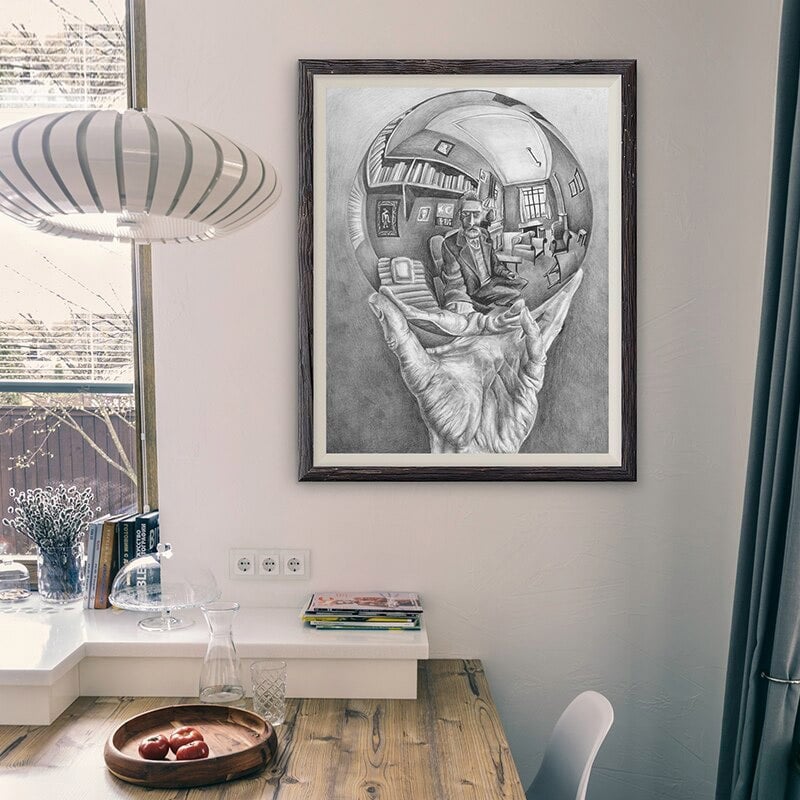
#Styles
The term ‘style’ or ‘art style’ is highly controversial among art historians today since it seems to be overtly restricting. In the visual arts, style has long been considered to be a “…distinctive manner which permits the grouping of works into related categories” (Gombrich).
We here use only a simplified version of the term to clarify a principle in interior design: Considering the stylistic design of your rooms will be helpful when choosing the right paintings for your home. Again, it is about being conscious of existing design elements that will assist you to either match the existing style or to eagerly choose to contrast. Here are some examples to elucidate the principle:
A streamlined retro look from the 1950s and 1960s has never gone out of fashion. This mid-century modern style can be matched with art from the same period, e.g., by a Jackson Pollock or Mark Rothko canvas wall art. If you want to build up some contrast, you might choose a much earlier print from the Baroque period or a contemporary piece from a living artist.
If you have designed your home in a Scandinavian style with functional, rustic furniture using natural materials and traditional craftsmanship, choosing a picture like “Wheat Field with Cypresses” by Vincent van Gogh with its sturdy brushstrokes and vibrant colours might be a streamlining decision. On the other hand, building up contrast would mean picking a photorealistic image or a Renaissance print for instance, which could either conjure up a mesmerizing effect.

An Art NouveauIn the desire to abandon the historical styles of the 19th century and overcome historicism in architecture and decoration, Art Noveau appeared in a wide variety of strands worldwide, most popular between 1890 and 1910. The movement is also known as the Glasgow Style, in the German-speaking world, as Jugendstil, or as Stile Liberty in Italian. Enthusiasts in the decorative More style home with delicate line patterns, parquet floor, Tiffany lamps, muted and soft colours of grays, mustard yellows, olives, and lilacs can be matched with art from the same period. You might want to choose a picture like the “Portrait of Adele Bloch-Bauer I” or “The Kiss” by Gustav Klimt. Since the Art NouveauIn the desire to abandon the historical styles of the 19th century and overcome historicism in architecture and decoration, Art Noveau appeared in a wide variety of strands worldwide, most popular between 1890 and 1910. The movement is also known as the Glasgow Style, in the German-speaking world, as Jugendstil, or as Stile Liberty in Italian. Enthusiasts in the decorative More style includes many decorative elements and floral motives, an effective contrast can be established by choosing canvas wall art with calmer compositions such as the colour field paintings by Mark Rothko.
Experience shows oftentimes that matching the styles already present will stylistically be more successful than trying to build up contrast, since streamlining the interior design and images will be fostering cohesiveness.
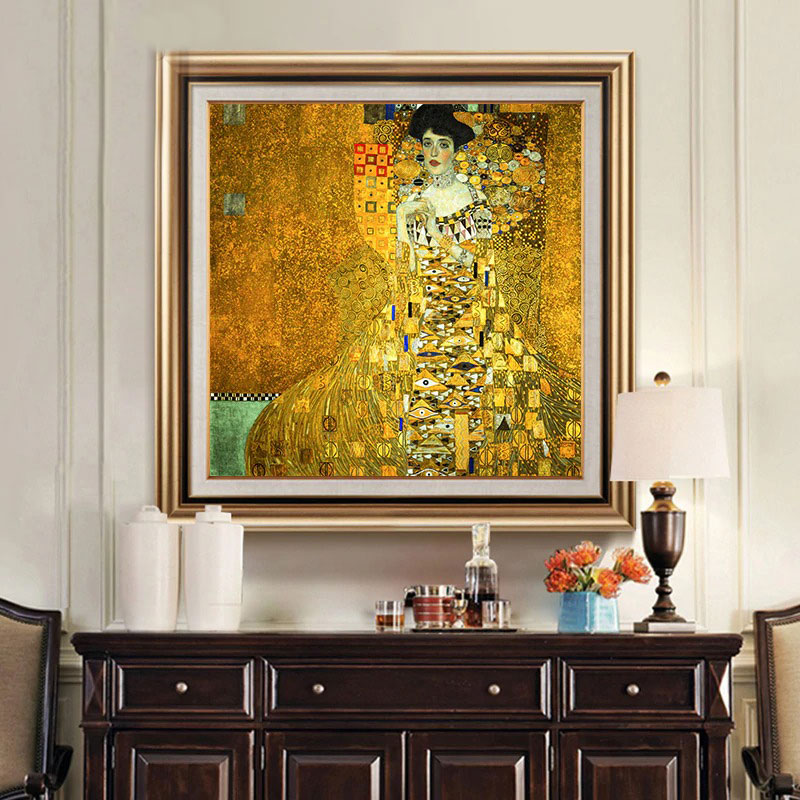
#Rooms
Every room from the kitchen, the living room, to the bathroom deserves to be invigorated by art and to be exuding your personal style. When choosing canvas wall art, it is important to have in mind what room it will be for and what atmosphere it should be breathing.
Living Room
You can make a big impact by picking the right artwork for the living room since it is here that you and your guests will spend the most time in. Choose a large statement and thought-provoking piece to display in a prominent area such as above the sofa or the wall facing the room entrance or opt for a gallery wall that best reflects you and your style. Klick through our large wall art Giclée print collection for living room wall art ideas.
Dining Room
The dining room, just like the living room, will also be a space that is shared with guests and should therefore be welcoming and presentable. Canvas wall art pieces which are thematically related work well, e.g., a still lifeStill Life refers to a genre of art that focuses on depicting inanimate objects. These objects are typically commonplace items, arranged in a composition to highlight their shapes, colors, textures, and forms. The genre is known for its attention to detail and the meticulous arrangement of elements, creating a sense of balance and harmony. Historical Background Still life painting has More depicting fruit or a table-picture such as Picasso’s “Clarinet, Bottle of Bass, Newspaper, Ace of Clubs”. Conversation provoking pieces are ideal for homeowners who like to host dinner parties.
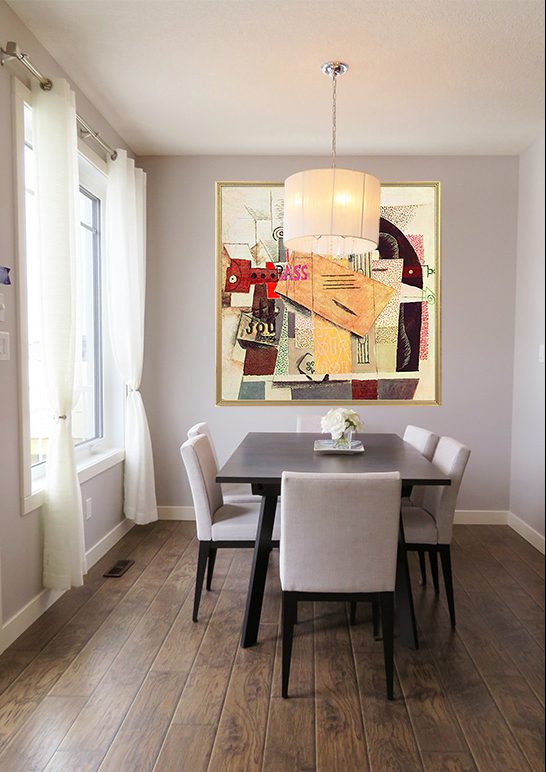
Bedroom
As a room of privacy and retreat, your bedroom should be a place for relaxation and rest. Pick canvas wall art for your bedroom that feels soothing and comfortable to you personally. If the bedroom acts as “home office” of the new normal as well, try to find a compromise between a relaxing and an inspiring atmosphere. One might think of pictures such as colour field paintings by Rothko, rhythmic images by Pollock, or the balanced compositions by Kandinsky.
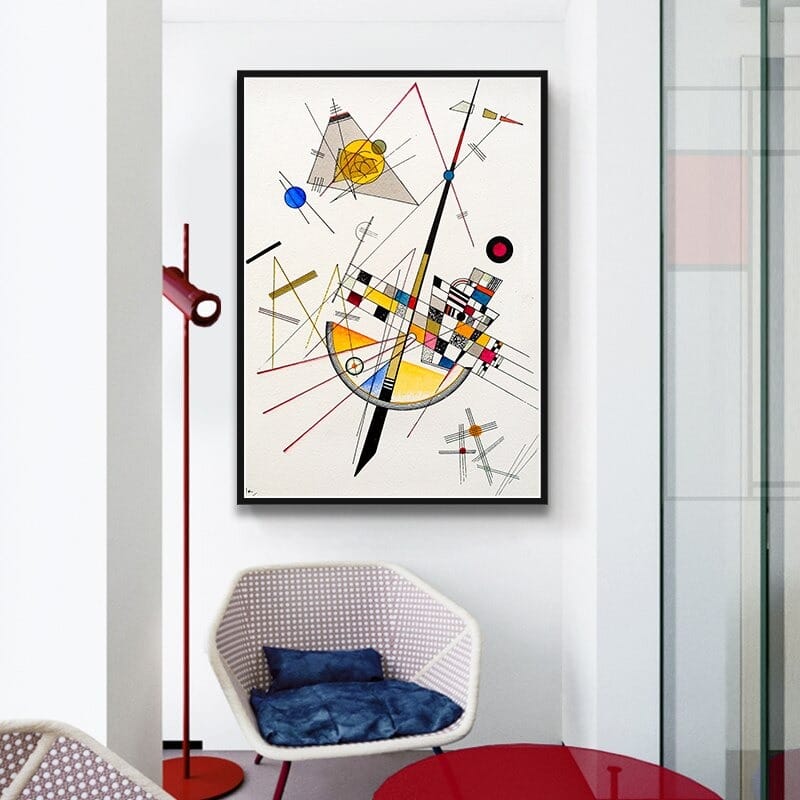
Study or Office
Spirit up your working space with images that truly inspire and refresh you. One piece of advice is to frequently change or rotate the imagery of your office or study to keep the sense of freshness. An easy way to accomplish this is by installing a floating ledge shelf close to your table and pick an assortment of artwork of medium to small-sized pieces to mix and match. Create coherence between the pictures by choosing frames and mats of the same style.
Kitchen
Spaces above cabinets or countertops are ideal spots for hanging art. Usually, smaller pieces will be most suitable, complementing rather than overwhelming the diverse structure of the kitchen. However, if you have free-standing walls available in your kitchen, try larger canvas wall art formats in vertical structure, which will rhythmize your spaces beautifully.
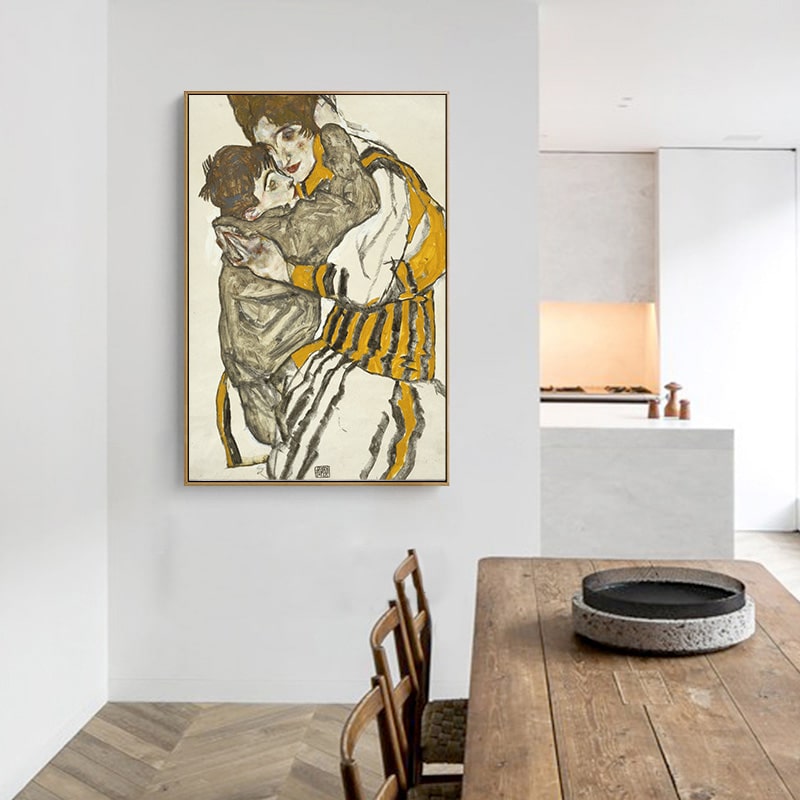
Bathroom
Art for the bathroom should likewise reflect the atmosphere of the space. Powder room for example can take an extra dose of brightness and joyfulness, e.g., with a thought-provoking piece by Magritte or Miró. The master bath should go with more calming or serene pieces, such as a landscape piece by Monet or Seurat. Bathroom art goes well in pairs, for example, two abstract pieces stacked or next to each other. Be sure to pick canvas wall art that is waterproof.
Hallways
Hallways are usually abundant in empty wall spaces and are ideal for creating galleries or for hanging large sized landscape format pieces. The rule of hanging art at eye level is crucial here, since the art should be enjoyable walking past.
Open Floor Plan
Open spaces like open plan kitchens and living rooms meld two distinct room functions into one. Art chosen for open spaces should both meet the criteria for every single room, and at the same time should exude a uniting atmosphere across the rooms. You can either choose a large wall art hanging to pull the spaces together or harmonize by creating a gallery art wall.
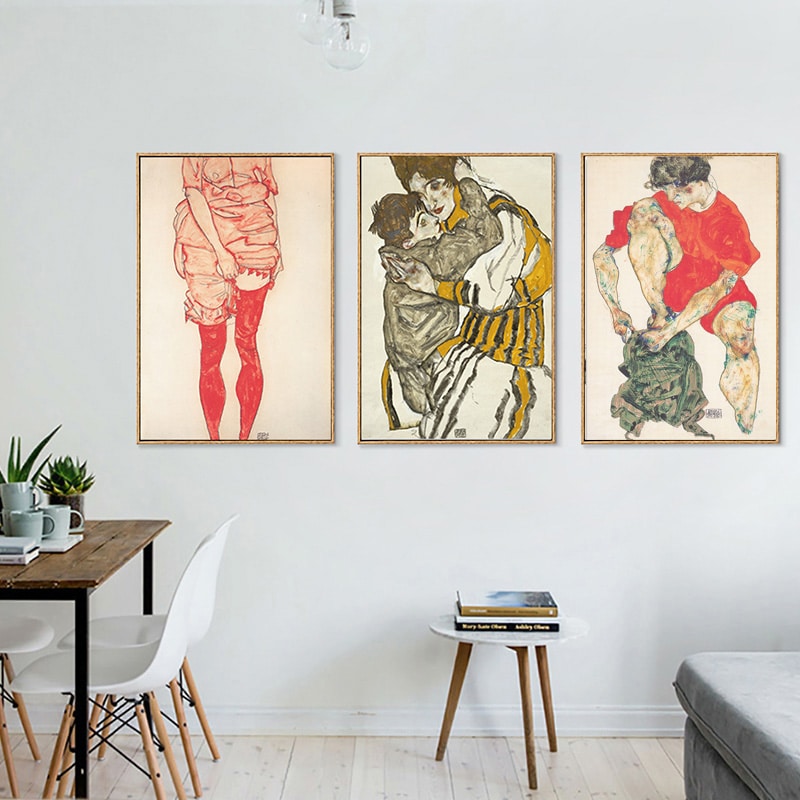
It’s all about stories
The beautiful thing about art is that you can tell your own story with every piece – and the story behind the piece as well as the artist. Educate yourself about the piece you are showcasing will make your choices more confident and easier. For this purpose, read the short introductions to every piece of canvas wall art we offer on our platform. Choosing artwork is very personal and intuitive. Keep those guidelines in mind, but let your impulses and emotions make the final decisions about what is the right art to put up in your home.
Your Questions in Brief: FAQ
Q: How do you choose wall art that goes together?
A: To choose wall art that complements each other, look for pieces that share a common element like color, theme, or art style. It creates a unified aesthetic without making the space look too monotonous. Consider the overall vibe you aim to achieve, whether it’s eclectic, modern, or classic. Balancing variety and coherence is key to a visually appealing collection.
Q: How to choose wall art for the living room?
A: The living room is a central space that reflects your style and gathers people together. Choose wall art that resonates with the room’s existing decor and color scheme. Art pieces that evoke comfort and conversation, such as vibrant landscapes or intriguing abstracts, are perfect. Ensure they complement, not overpower, the space.
Q: How to decide on wall art?
A: Deciding on wall art involves considering the mood you wish to set and the style you want to portray. Assess the colors and patterns present in your existing décor to ensure a harmonious blend. Art should be a reflection of your personality and taste, making your space truly yours. It’s not just about filling walls but making statements that resonate.
Q: How to choose the right size art for a wall?
A: To choose the right size art for a wall, consider the scale relative to your furniture and the wall’s dimensions. A large blank wall can accommodate a single large piece or a collection of smaller pieces. The artwork should fill about two-thirds of the available space. Measure before purchasing to ensure a perfect fit.
Q: How to choose art for walls?
A: When choosing art for walls, it’s essential to consider the room’s function and the existing aesthetic. Opt for calming, serene pieces in bedrooms and vibrant, energetic art in living spaces. The artwork should reflect your personal style and complement the room’s color paletteA color palette refers to a selection of colors used in design and art. It can set the tone, convey emotions, and highlight key elements. color wheel Types of Color Palettes • Monochromatic: Uses variations in lightness and saturation of a single color. Ideal for creating a harmonious and cohesive look. • Analogous: Combines colors that are next to each More. It’s about creating a cohesive look that enhances the overall ambiance.
Q: How to choose wall art for a dining room?
A: In dining rooms, wall art should complement both the furniture and the atmosphere of gatherings. Choose pieces that stimulate conversation and enhance the dining experience. Art with food themes or dramatic landscapes can add depth and interest. Keep the scale in proportion to your dining table and surrounding space.
Q: How to set up wall art?
A: Setting up wall art effectively requires careful planning and consideration of spacing. Hang artwork at eye level, which is generally 57 to 60 inches from the floor. For gallery walls, maintain consistent spacing between each piece to achieve a cohesive look. Use appropriate hooks and anchors to ensure that the art is securely mounted.
Q: How to choose art for a gallery wall?
A: Choosing art for a gallery wall involves selecting various pieces that complement each other while showcasing diverse sizes and frames. Start with a central piece and build around it, mixing textures, colors, and styles for depth. Keep the spacing even to create a unified display. This setup allows for personal expression and a dynamic visual impact.
Q: How to choose a wall mural?
A: When choosing a wall mural, consider the room’s scale and the visual impact you want to achieve. Wall murals can dramatically alter the perception of space by adding depth or opening up a room. Opt for a design that complements the room’s theme and color paletteA color palette refers to a selection of colors used in design and art. It can set the tone, convey emotions, and highlight key elements. color wheel Types of Color Palettes • Monochromatic: Uses variations in lightness and saturation of a single color. Ideal for creating a harmonious and cohesive look. • Analogous: Combines colors that are next to each More. A well-chosen mural can become a stunning focal point.
Q: How to choose wall art for coastal homes?
A: For coastal homes, select wall art that reflects the surrounding environment and enhances the airy, light feel typical of such settings. Artworks featuring seascapes, marine life, or beach scenes are ideal. Use light frames or canvas wraps to maintain a casual, breezy vibe. The colors should be soft, incorporating blues, greens, and sandy neutrals.
Q: How to display artwork without walls?
A: Displaying artwork without traditional walls can be creative—use easels, shelves, or picture ledges. Freestanding panels or screens can also serve as unique backdrops for art displays. This approach is flexible, allowing you to easily change or rotate pieces. It’s perfect for adding artistic touches to spaces with limited wall availability.
Q: How to choose art for a large wall?
A: Large walls offer a fantastic opportunity to make a bold statement with oversized art or a curated collection of smaller pieces. Consider a large canvas that acts as a visual anchor or a series of prints that tell a story. Ensure the artwork’s theme resonates with the room’s overall decor. Scale is crucial; too small pieces can look lost.
Q: How to choose art for gallery walls?
A: When selecting art for gallery walls, aim for a balanced mix of sizes, mediums, and frames to create an engaging visual narrative. Start with the largest piece and arrange others around it to maintain visual balance. Include personal items like photographs or handmade pieces for a touch of uniqueness. Consistency in spacing and alignment ensures a polished look.
Q: How to choose the right size wall art?
A: Choosing the right size wall art is crucial for maintaining balance in a room. Measure the space available and consider that large pieces work well as focal points in spacious rooms, while smaller artworks are suitable for intimate areas. Avoid overwhelming a small room with too large a piece. Conversely, a too-small piece on a large wall might look out of place.
Q: How to choose wall art for your home?
A: Choosing wall art for your home involves understanding the scale of your spaces, the existing decor, and your personal aesthetic preferences. Art should complement the room’s function and style, adding to the overall ambiance. Consider artworks that reflect your interests and passions. Art is not just decorative but also an expression of your personality.
Q: How to decide on wall decor?
A: To decide on wall decor, evaluate the style and atmosphere of each room. Consider the wall size and color, furniture style, and the room’s lighting. Wall decor should enhance the room’s aesthetic without overwhelming it. Choose pieces that speak to you personally and fit the purpose of the space.
Q: How to choose the right wall decor?
A: Choosing the right wall decor involves balancing aesthetics and room functionality. Assess the size and orientation of the space to determine the scale of decor needed. Select pieces that complement the existing interior design and color scheme. Well-chosen decor can transform a room, making it feel complete and inviting.
You might be interested in these posts by Pigment Pool:
Trailblazing Pop Art: Female Artists from Iconic Pioneers to Emerging Voices
Pop Art and Graffiti: What is the Difference?
Gustav Klimt Inspired Art: Golden Influence on Modern Media and Pop Culture
The Art of Hanging Art: How to Follow and Break Rules
Looking to spruce up your budget for buying great art? Try these 10 tips for making some extra money!
